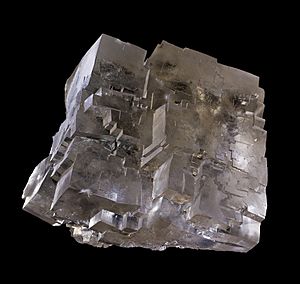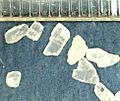Table salt facts for kids
Table salt is a common mineral found all around us. It's mostly made of a chemical compound called sodium chloride (NaCl). You might know it as rock salt or halite when it's found naturally as a crystal.
When salt mixes with water, it dissolves and creates a salty solution. The ocean is full of salt! About 3.5% of seawater is salt, which means there are about 35 grams of salt in every liter of ocean water.
People get salt in two main ways: by letting water evaporate or by mining it from the ground. To get sea salt, people build special pools and fill them with sea water. The sun and wind make the water disappear, leaving the salt behind.
Contents
Salt with Added Goodness
Some table salt has extra ingredients added to it. These are often put in to help with health problems, especially in poorer countries. The types and amounts of these extra ingredients can be different depending on the country.
Why Iodine is Important
Iodine is a very important nutrient for people. If someone doesn't get enough iodine, their body might not make enough of a hormone called thyroxine. This can cause problems like a swollen thyroid gland (called endemic goitre) in adults, or even affect brain development in children (called cretinism).
Since 1924, people have added iodine to salt to help prevent these problems. This is called iodized salt. It has a tiny bit of potassium iodide, sodium iodide, or sodium iodate mixed in. Sometimes, a little bit of dextrose (a type of sugar) is added to keep the iodine stable.
Not getting enough iodine affects about two billion people worldwide. It's the main cause of intellectual disabilities that can be prevented. Iodized table salt has really helped reduce these problems in countries where it's used.
The amount of iodine in salt can be different. For example, in the United States, the Food and Drug Administration (FDA) suggests people get 150 micrograms of iodine each day. US iodized salt has about 46–77 parts per million (ppm) of iodine, while in the UK, it's 10–22 ppm.
Keeping Salt Flowing Freely
Sometimes, things like Sodium ferrocyanide (also called yellow prussiate of soda) are added to salt. These are called anticaking agents. They stop the salt from clumping together, so it pours easily. People have been adding these agents since at least 1911, when magnesium carbonate was first used.
Other things that can be added to stop clumping include tricalcium phosphate, calcium or magnesium carbonates, and silicon dioxide.
Double the Goodness: Iron and Folic Acid
Some salt is "doubly fortified," meaning it has both iodine and iron added. Adding iron helps with iron deficiency anemia, which can affect how babies' brains develop. A common source of iron added is ferrous fumarate.
Another important additive, especially for pregnant women, is folic acid (which is vitamin B9). This can make the salt look a bit yellow. Folic acid helps prevent serious birth defects and anemia in young mothers, especially in developing countries.
Stronger Teeth with Fluoride
Not having enough fluoride in your diet can lead to more dental caries (tooth decay). So, fluoride salts can be added to table salt to help reduce cavities. This is more common in some European countries where water doesn't have added fluoride. In France, for example, 35% of the table salt sold has sodium fluoride added.
Other Kinds of Salt
There are many different kinds of salt, each with its own special qualities.
Sea Salt
Unrefined sea salt comes straight from the ocean and isn't processed much. It has small amounts of other minerals like magnesium and calcium. These can give it a slightly bitter taste. Sea salt also tends to absorb moisture from the air easily.
Sometimes, sea salt can have a mild "fishy" smell from tiny bits of algae. The color can also be a dull gray depending on where it comes from. Because of these extra bits, sea salt might have a more complex flavor than pure sodium chloride when sprinkled on food. However, when you cook with it, these subtle flavors usually get lost in the food's taste.
Specialty Salts
- Fleur de sel: This is a natural sea salt that forms on the surface of evaporating salt pans. It has a unique flavor that changes based on its source.
- Bamboo salt: In traditional Korean cuisine, this salt is made by roasting salt inside a bamboo container that's sealed with mud. It's said to get minerals from the bamboo and mud.
- Kosher salt: This salt has bigger grains than regular table salt. It's often used in cooking for things like brining meat or making bread and pretzels. It can also be used as a scrubbing agent with oil.
- Pickling salt: This salt has very fine grains, which helps it dissolve quickly to make brine for pickling foods.
Salt in Our Food
Salt is found in most foods, but in natural foods like meat, vegetables, and fruit, there's usually only a tiny amount. It's often added to processed foods like canned foods, pickled foods, and snack foods. Salt helps keep food from spoiling and also makes it taste better.
Before refrigerators were invented, salting was one of the main ways to keep food fresh. For example, fresh herring has only 67 mg of sodium per 100 grams, but kipper (which is preserved herring) has 990 mg! Similarly, fresh pork has 63 mg of sodium, while bacon has 1,480 mg. Potatoes have 7 mg, but potato crisps (potato chips) have 800 mg per 100 grams.
Salt is also used a lot in cooking to add flavor. Techniques like cooking with salt crusts or brining meat use a lot of salt. In Western diets, the main sources of salt (besides adding it directly) are bread, cereals, meat products, and milk and dairy products.
In many East Asian cultures, salt isn't traditionally used as a table condiment. Instead, things like soy sauce, fish sauce, and oyster sauce are used. These sauces are very high in sodium and serve a similar purpose to table salt in Western cooking. They are usually used for cooking rather than being put on food at the table.
Images for kids
-
Salt production in Halle, Saxony-Anhalt (1670)
-
Ponds near Maras, Peru, fed from a mineral spring and used for salt production since the time of the Incas.
-
SEM image of a grain of table salt
-
Comparison of table salt with kitchen salt. Shows a typical salt shaker and salt bowl with salt spread before each on a black background.
-
Irregular crystals of sea salt
-
Sea salt evaporation pond at Walvis Bay. Halophile organisms make it red.
-
Bread and salt at a Russian wedding ceremony
See also
 In Spanish: Sal común para niños
In Spanish: Sal común para niños











